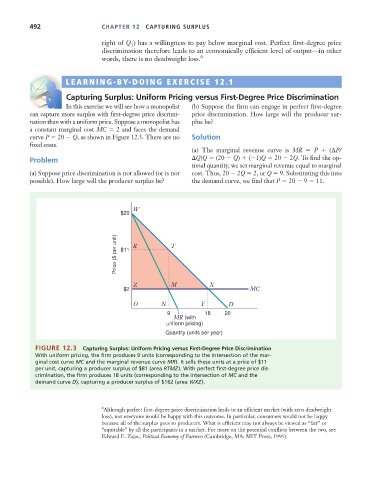Page 518 - Microeconomics, Fourth Edition
P. 518
c12capturingsurplus.qxd 7/22/10 10:41 AM Page 492
492 CHAPTER 12 CAPTURING SURPLUS
right of Q ) has a willingness to pay below marginal cost. Perfect first-degree price
1
discrimination therefore leads to an economically efficient level of output—in other
words, there is no deadweight loss. 6
LEARNING-BY-DOING EXERCISE 12.1
S
D
E
Capturing Surplus: Uniform Pricing versus First-Degree Price Discrimination
In this exercise we will see how a monopolist (b) Suppose the firm can engage in perfect first-degree
can capture more surplus with first-degree price discrimi- price discrimination. How large will the producer sur-
nation than with a uniform price. Suppose a monopolist has plus be?
a constant marginal cost MC 2 and faces the demand
curve P 20 Q, as shown in Figure 12.3. There are no Solution
fixed costs.
(a) The marginal revenue curve is MR P ( P/
Problem Q)Q (20 Q) ( 1)Q 20 2Q. To find the op-
timal quantity, we set marginal revenue equal to marginal
(a) Suppose price discrimination is not allowed (or is not cost. Thus, 20 2Q 2, or Q 9. Substituting this into
possible). How large will the producer surplus be? the demand curve, we find that P 20 9 11.
$20 W
Price ($ per unit) $11 R T
Z M X
$2
MC
O N Y
D
9 18 20
MR (with
uniform pricing)
Quantity (units per year)
FIGURE 12.3 Capturing Surplus: Uniform Pricing versus First-Degree Price Discrimination
With uniform pricing, the firm produces 9 units (corresponding to the intersection of the mar-
ginal cost curve MC and the marginal revenue curve MR). It sells these units at a price of $11
per unit, capturing a producer surplus of $81 (area RTMZ). With perfect first-degree price dis-
crimination, the firm produces 18 units (corresponding to the intersection of MC and the
demand curve D), capturing a producer surplus of $162 (area WXZ).
6 Although perfect first-degree price discrimination leads to an efficient market (with zero deadweight
loss), not everyone would be happy with this outcome. In particular, consumers would not be happy
because all of the surplus goes to producers. What is efficient may not always be viewed as “fair” or
“equitable” by all the participants in a market. For more on the potential conflicts between the two, see
Edward E. Zajac, Political Economy of Fairness (Cambridge, MA: MIT Press, 1995).

